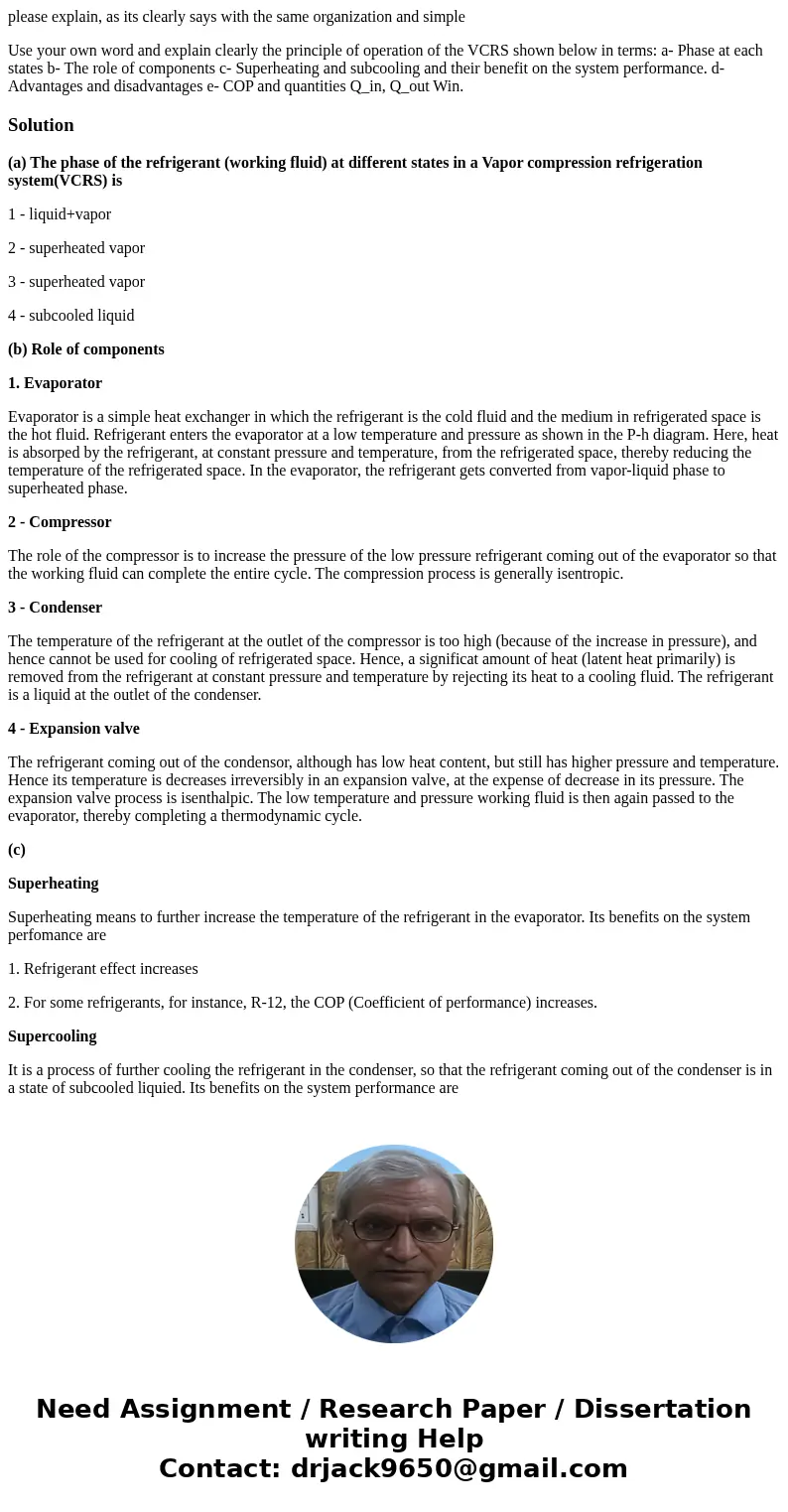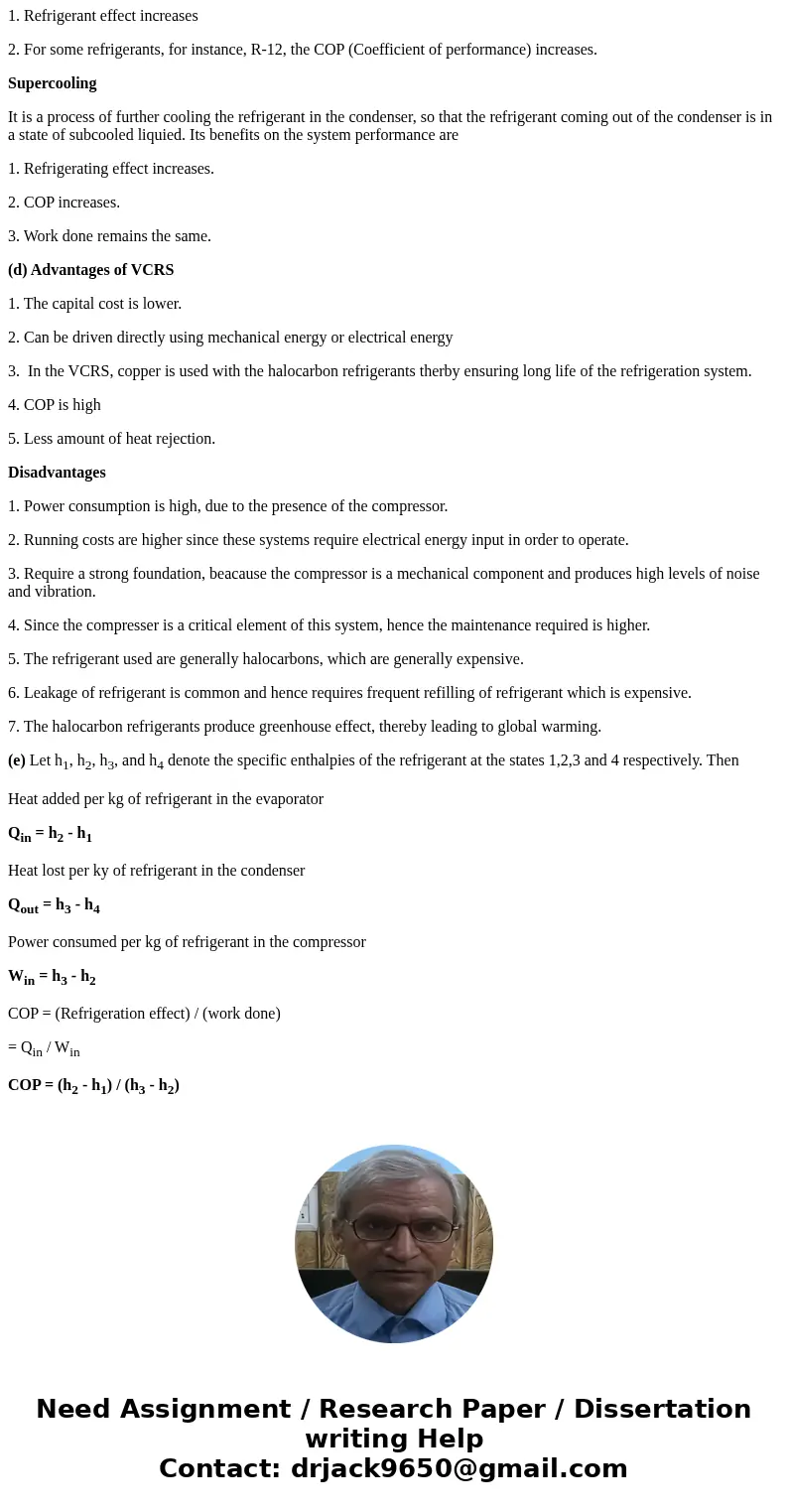please explain as its clearly says with the same organizatio
please explain, as its clearly says with the same organization and simple
Use your own word and explain clearly the principle of operation of the VCRS shown below in terms: a- Phase at each states b- The role of components c- Superheating and subcooling and their benefit on the system performance. d- Advantages and disadvantages e- COP and quantities Q_in, Q_out Win.Solution
(a) The phase of the refrigerant (working fluid) at different states in a Vapor compression refrigeration system(VCRS) is
1 - liquid+vapor
2 - superheated vapor
3 - superheated vapor
4 - subcooled liquid
(b) Role of components
1. Evaporator
Evaporator is a simple heat exchanger in which the refrigerant is the cold fluid and the medium in refrigerated space is the hot fluid. Refrigerant enters the evaporator at a low temperature and pressure as shown in the P-h diagram. Here, heat is absorped by the refrigerant, at constant pressure and temperature, from the refrigerated space, thereby reducing the temperature of the refrigerated space. In the evaporator, the refrigerant gets converted from vapor-liquid phase to superheated phase.
2 - Compressor
The role of the compressor is to increase the pressure of the low pressure refrigerant coming out of the evaporator so that the working fluid can complete the entire cycle. The compression process is generally isentropic.
3 - Condenser
The temperature of the refrigerant at the outlet of the compressor is too high (because of the increase in pressure), and hence cannot be used for cooling of refrigerated space. Hence, a significat amount of heat (latent heat primarily) is removed from the refrigerant at constant pressure and temperature by rejecting its heat to a cooling fluid. The refrigerant is a liquid at the outlet of the condenser.
4 - Expansion valve
The refrigerant coming out of the condensor, although has low heat content, but still has higher pressure and temperature. Hence its temperature is decreases irreversibly in an expansion valve, at the expense of decrease in its pressure. The expansion valve process is isenthalpic. The low temperature and pressure working fluid is then again passed to the evaporator, thereby completing a thermodynamic cycle.
(c)
Superheating
Superheating means to further increase the temperature of the refrigerant in the evaporator. Its benefits on the system perfomance are
1. Refrigerant effect increases
2. For some refrigerants, for instance, R-12, the COP (Coefficient of performance) increases.
Supercooling
It is a process of further cooling the refrigerant in the condenser, so that the refrigerant coming out of the condenser is in a state of subcooled liquied. Its benefits on the system performance are
1. Refrigerating effect increases.
2. COP increases.
3. Work done remains the same.
(d) Advantages of VCRS
1. The capital cost is lower.
2. Can be driven directly using mechanical energy or electrical energy
3. In the VCRS, copper is used with the halocarbon refrigerants therby ensuring long life of the refrigeration system.
4. COP is high
5. Less amount of heat rejection.
Disadvantages
1. Power consumption is high, due to the presence of the compressor.
2. Running costs are higher since these systems require electrical energy input in order to operate.
3. Require a strong foundation, beacause the compressor is a mechanical component and produces high levels of noise and vibration.
4. Since the compresser is a critical element of this system, hence the maintenance required is higher.
5. The refrigerant used are generally halocarbons, which are generally expensive.
6. Leakage of refrigerant is common and hence requires frequent refilling of refrigerant which is expensive.
7. The halocarbon refrigerants produce greenhouse effect, thereby leading to global warming.
(e) Let h1, h2, h3, and h4 denote the specific enthalpies of the refrigerant at the states 1,2,3 and 4 respectively. Then
Heat added per kg of refrigerant in the evaporator
Qin = h2 - h1
Heat lost per ky of refrigerant in the condenser
Qout = h3 - h4
Power consumed per kg of refrigerant in the compressor
Win = h3 - h2
COP = (Refrigeration effect) / (work done)
= Qin / Win
COP = (h2 - h1) / (h3 - h2)


 Homework Sourse
Homework Sourse